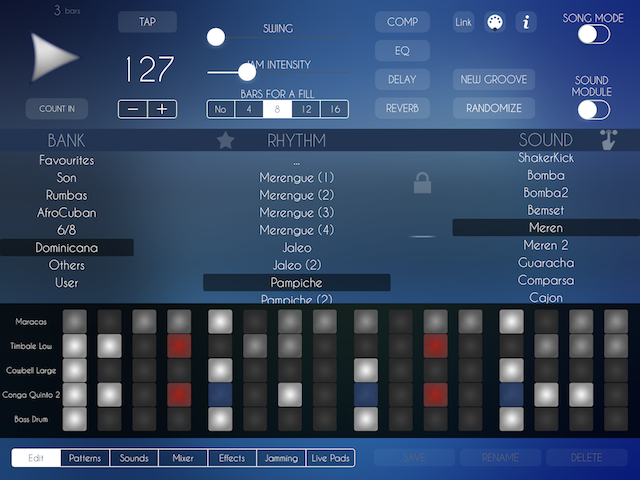Dominican Rhythms
Included rhythms in Afro Latin Drum Machine (iPad - iPhone)
Dominican Rhythms
Merengue, although not Afro-Cuban, is an important rhythm with African roots. Merengue is a rhythm and dance from the Dominican Republic, the Spanish-speaking part of the island called Española. Haiti is the other part of the island and has wonderful folk and popular music, including its own version of merengue.
The basic pattern of merengue traditionally has three parts of sections. The first section is called Merengue. The second section is called Jaleo. The third section sometimes referred to as the "rolling section" is called Apanpichao or Pampiche.
A double-headed drum, the tambora, plays an important role in the rhythm of merengue. The drum is played sideways with both hands, one with a stick and the other without. The downbeats are played by hand, while the stick plays the syncopations; both play different figures of open drums. The congas are now used together with the tambora in the dance bands. A metal torpedo-shaped guide, called a guira, played with a metal scraper, is also used in meringue.
Although the clave is not played with merengue, the rhythm is adjusted to more than 3-2 clave.
Merengue
Typical merengue is the oldest style of merengue still practiced today (generally in the Dominican Republic and the United States), its origins go back to the 1850s. It originated in the rural town of Navarrete (villa bisono), in the northern region of the valley around the city of Santiago called the Cibao, resulting in the term "Cibaeño merengue". It was originally played on the metal scraper called the güira, the Tambora, and a stringed instrument (usually a guitar or a variant like the tres). The stringed instruments were replaced by two-row diatonic accordions when the Germans began to travel to the island in the 1880s as part of the tobacco trade. Later, the marimbula, a bass lamellophone related to the African mbira, was added to complete the sound.
Jaleo
Jaleo is the climax of merengue and is composed of energetic and syncopated movements that take a chorus of the main theme to give musicians and dancers the opportunity to showcase their skills.
With the addition of the saxophone to the merengue, this instrument has acquired a prominent role in the racket, something that was not contemplated in 1930. It consists of a repetitive pattern of harmony and dominant tones. The jaleo is accepted as an addition of Cibaeño merengue to this manifestation of one of the Dominican national melodies.
Pampiche
Pampiche or Apampichao is the variation of Merengue played in the style of pambiche, a slower and more rhythmic variation in which both dancers usually remain embraced.

Bachata
A hybrid of bolero and other musical references, including Cuban son. Dance and bachata lessons are very sensual, as they are danced in pairs with a position closer to salsa for example. The dance is always a little bent and with the legs interspersed creating that union of couple so the boy can mark the steps helping you with the knees.